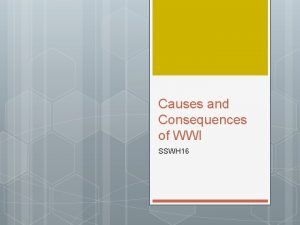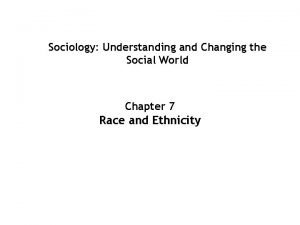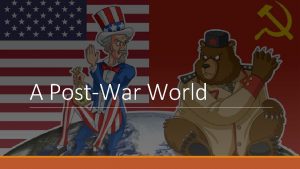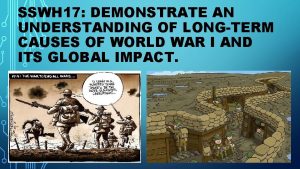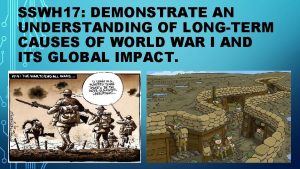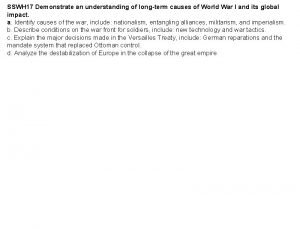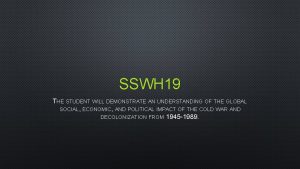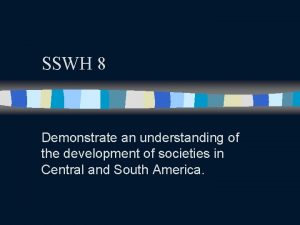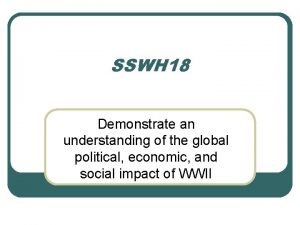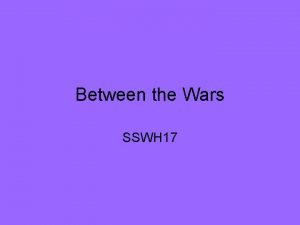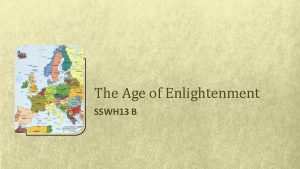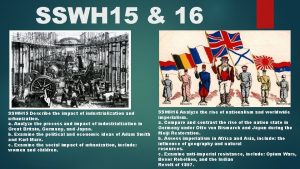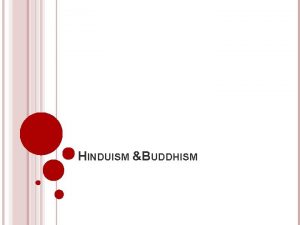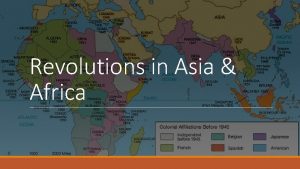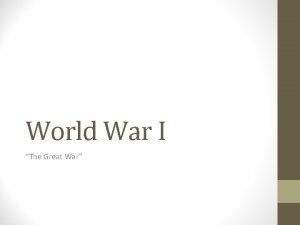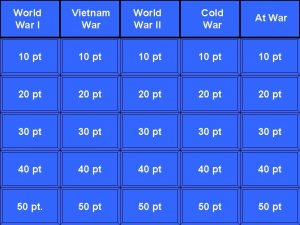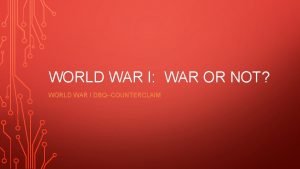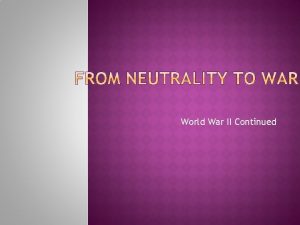World War I SSWH 17 Demonstrate an understanding
























- Slides: 24

World War I •

SSWH 17 - Demonstrate an understanding of longterm causes of World War I & its global impact. a. Identify causes of the war, include: nationalism, entangling alliances, militarism, & imperialism.

Students will be able to: • Explain how industrialization, imperialism, nationalism, militarization, & the alliance system worked together & led to World War I • Explain how these factors created the “powder keg of Europe” in the Balkans that sparked the global conflict • Describe how industrialization affected the battlefronts of World War I • Analyze the impacts on the countries who fought in World War I

World War I: The Causes • A combination of factors led to World War I • Industrialization • Led to a high demand from products • Need for more resources to produce goods • Need for new markets to sell goods • Imperialism • Arose from need from new markets & more resources due to industrialization • Conflict between European countries, as well as U. S. & Japan, arose during colonization of Africa, Asia, & Australia • Militarism • Competing countries used industry to produce bigger & better weapons (Military Build Up)

World War I: The Causes • A combination of factors led to World War I • Alliances • Militarism led to instability in Europe • European countries began to from alliances to balance power & keep the peace • Alliances tended to be secretive & unstable which led to even more conflict & competition • Nationalism • Countries began to build up nationalist sentiment because of competition • Ethnic groups like the Slavs began to be suppressed & oppressed


World War I: Causes • Germany’s Otto von Bismarck works to keep peace in Europe after 1871 • Believes France wants revenge for loss in 1870 Franco-Prussian War • Seeks to isolate the French with a series of treaties & alliances: • signs treaty with Russia in 1881 • forms Triple Alliance — Germany, Austria-Hungary, Italy — in 1882

World War I: Causes • Kaiser Wilhelm II becomes German ruler in 1888 • Foreign policy changes begin in 1890 with dismissal of Bismarck • alliance with Russia dropped; Russia then allies with France • effort to strengthen German navy, which alarms Britain • Britain, France, Russia form Triple Entente alliance in 1907

World War I: Causes • A Restless Region • Many groups in Balkans win independence during early 1900 s • New nation of Serbia made up largely of Slavs • Austria-Hungary annexes Slavic region Bosnia & Herzegovina (1908) • Serbia outraged, sees itself as rightful ruler of these Slavic lands • A Shot Rings Throughout Europe • Serbian rebel from an ultra-nationalist Slavic organization called the Black Hand kills Austro-Hungarian crown prince Archduke Franz Ferdinand in June 1914 • Austria declares war on Serbia; Russia comes to aid of Serbia



World War I The Outset of War

SSWH 17 - Demonstrate an understanding of longterm causes of World War I and its global impact. • b. Describe conditions on the war front for soldiers, include: new technology & war tactics


World War I: The Combatants

World War I • World War I was fought on 3 principal fronts: • Western Front • between France & Germany • Eastern Front • between Russia & Germany • At Sea • between the British & Germany • First conflict with industrialized warfare • Technological advances had both positive & negative affects on the war

World War I: Technological Advances • Germans develop synthetic rubber • Germans & British create new chemical weapons • Mustard Gas • • • Advances in firearms Flamethrowers Tanks Fighter planes developed Medical advancements • mobile x-ray units • rudimentary blood banks • reconstructive surgery

World War I: Western Front • Quickly developed a reputation for slaughter • Nicknamed “The Meat Grinder” • 500 -mile long network for trenches, bunkers, minefields, machine gun nests, & artillery • ran from Switzerland to the English Channel • Represented both the failures & successes of industrialized warfare • Mass production of weapons & ammunition made defensive positions easy to hold • Weak transportation technology made offense difficult • Led to a stalemate on Western Front

World War I: Western Front • Life on the Western Front for soldiers was horrible • Soldiers were confined to trenches & underground bunkers by the constant threat of artillery, gunfire and poison gas • Trenches were muddy leading to chronic foot infections known as trench foot, serious cases could lead to amputations • Vermin were everywhere and • Disease was common • Massive losses for both sides at battles of Verdun and Somme (1916)


World War I: Western Front • Schlieffen Plan — German plan to quickly defeat France, then fight Russia in order to avoid a 2 -front war • • German army quickly advances to outskirts of Paris Forced to retreat at First Battle of the Marne Schlieffen Plan fails Germany has to fight 2 -front war

World War I: Eastern Front • Fighting along the Eastern Front demonstrated the superiority of highly industrialized nations over their less industrialized counterparts • By 1914, Germany was an industrial powerhouse while Russia was only in the early phases of industrialization • As a result, Germany dominated the Eastern Front • Russia was only able to hold off German forces with superior manpower & support from their allies • Germany’s domination of the Eastern Front led to a revolution in Russia & Russia’s subsequent withdrawal from the war in 1917

World War I: Naval Warfare • The success of the Allied Powers was largely due to the British Navy • Britain used superior weaponry, including underwater mines, to blockade Germany • The blockade cut off Germany from its colonies & raw materials • Germany tried to retaliate by using submarines to blockade Britain • Blockade was mildly successful • A German U-boat sank the British passenger liner Lusitania in 1915 • several American civilians were on board • The sinking of the Lusitania shifted U. S. public opinion towards war • The U. S. entered the war in 1917 • With the support of American factories, the American Navy, & American soldiers the Allies were able to outlast the Central Powers leading to an Allied victory in 1919

World War I: Outside of Europe • The Gallipoli Campaign • • Allies move to capture Ottoman Dardanelles strait in February 1915 Hope to defeat Ottoman Empire, a Central Powers ally Also want to open a supply line through region to Russia Effort ends in costly Allied defeat • Battles in Africa and Asia Allies take control of German holdings in Asia, Africa Britain & France use their colonial subjects to help in war effort Soldiers from colonies fought in colonies & in Europe The deployment of troops from all over the world spread a particularly deadly strain of flu virus • From 1918 to 1919 soldiers spread this strain of flu to almost every person on earth & it killed 1 in 40 of those infected, more than 20 million people • •
 Sswh tax
Sswh tax Primary deity of sangam period
Primary deity of sangam period Sswh
Sswh Demonstrate knowledge and understanding
Demonstrate knowledge and understanding Sociology understanding and changing the social world
Sociology understanding and changing the social world Debunking motif definition
Debunking motif definition War at home and abroad madison
War at home and abroad madison Korean war vietnam war venn diagram
Korean war vietnam war venn diagram Lesson 1 the cold war begins
Lesson 1 the cold war begins Truman vs eisenhower venn diagram
Truman vs eisenhower venn diagram Why did josette dugas want to go to war
Why did josette dugas want to go to war Ich war du warst er sie es war
Ich war du warst er sie es war Tug of war or tug-of-war
Tug of war or tug-of-war Why was the civil war the first modern war
Why was the civil war the first modern war Bringen pasado simple
Bringen pasado simple Toward civil war lesson 3 secession and war
Toward civil war lesson 3 secession and war Proxy wars in the cold war
Proxy wars in the cold war Chapter 30 the war to end war
Chapter 30 the war to end war Chapter 30 the war to end war
Chapter 30 the war to end war Definite rhyme scheme
Definite rhyme scheme The contest at mount carmel
The contest at mount carmel Explain demonstrate imitate practice
Explain demonstrate imitate practice Bicultural couples tend to demonstrate extremes in
Bicultural couples tend to demonstrate extremes in What does this image demonstrate?
What does this image demonstrate? Miller and urey's experiments attempted to demonstrate
Miller and urey's experiments attempted to demonstrate


